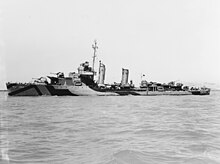USS Drayton (DD-366)

| |
| History | |
|---|---|
| Namesake | Percival Drayton |
| Builder | Bath Iron Works |
| Laid down | 20 March 1934 |
| Launched | 26 March 1936 |
| Commissioned | 1 September 1936 |
| Decommissioned | 9 October 1945 |
| Stricken | 24 October 1945 |
| Nickname(s) | "Blue Beetle"[1] |
| Fate | Sold for scrap, 20 December 1946 |
| General characteristics | |
| Class and type | Mahan class destroyer |
| Displacement | 1,500 tons |
| Length | 341 ft 4 in (104.04 m) |
| Beam | 35 ft (10.67 m) |
| Draft | 9 ft 10 in (3 m) |
| Speed | 37 knots (69 km/h) |
| Complement | 158 officers and crew |
| Armament |
|
USS Drayton (DD-366) was a
Drayton was launched 26 March 1936 by the Bath Iron Works, Bath, Maine; sponsored by Miss B. E. Drayton, great-grandniece of Captain Drayton, and commissioned 1 September 1936.
Service history
After her shakedown cruise to
Drayton's homeport from 12 October 1939 was Pearl Harbor. With war raging in Europe and tension increasing in the pacific, Drayton joined in the constant exercises and tactical problems preparing the fleet for action.
World War II
Underway as plane guard for

Drayton sailed from Pearl Harbor 17 November 1942 for action in the
Drayton sailed from Nouméa 13 May 1943 as escort for a transport convoy and arrived at Townsville, Australia 4 days later. Through the summer, she escorted Australian transports carrying troops from Townsville to Milne Bay for the lengthy fighting on vast New Guinea. Drayton patrolled and gave fire support during the invasion landings at Lae on 4 September and bombarded Finschhafen on 22 September.
After brief overhaul at
Drayton carried troops for the invasion of Los Negros Island in the Admiralty Islands. Here she joined in the bombardment 29 February 1944 and remained to provide fire support. She returned with reinforcement troops from Milne Bay 4 March and began operating as headquarters for the Landing Craft Control Officer for the Admiralties. Drayton bombarded Pityilu Island 12 March then sailed for Seeadler Harbor, Manus, escorting an LST convoy before returning to New Guinea.
The destroyer got underway from Milne Bay, New Guinea, 22 March 1944 and escorted transports to

Drayton reported to the
Her repairs completed, Drayton sailed from Manus 26 December 1944 for the invasion of Lingayen Gulf, Luzon, 9 January 1945. She gave fire support until the 13th, then sailed to San Pedro Bay to escort a support convoy to the beachhead. From 27 January to 18 February, she served on patrol and gave fire support, bombarding enemy troops in the foothills and destroying a strong point in a cave.
Continuing to operate in the Philippines, Drayton participated in the landings at
On 23 April 1945, Drayton stood out of San Pedro Bay for the invasion of Borneo, screening the actions at Tarakan from 1 to 27 May and at Balikpapan from 1 to 21 July. Returning to Manila 29 July, she got underway 7 August, and arrived at New York 12 September.
Drayton was decommissioned 9 October 1945 and sold for scrap 20 December 1946.
Awards
Drayton received 11
Legacy
The USS Drayton is depicted on the insignia of the Bath, Maine Fire Department.
References
- ISBN 9780688062743.
- This article incorporates text from the public domain Dictionary of American Naval Fighting Ships. The entry can be found here.
